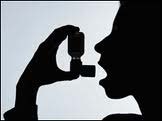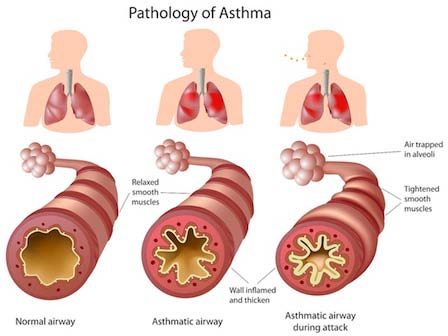Slide


An interprofessional case study
THIS CLINICAL TRAINING INITIATIVE IS SUPPORTED BY FUNDING FROM THE AUSTRALIAN GOVERNMENT UNDER THE INCREASED CLINICAL
TRAINING CAPACITY (ICTC) PROGRAM

Asthma - an interprofessional case study
At the end of this presentation students will be able to:
• Give a definition of asthma• Discuss what could cause asthma• Identify four triggers of asthma• Describe symptoms of an asthma flare-up• Explain three asthma treatment strategies• Develop an interprofessional plan of care for
an asthma sufferer
THIS CLINICAL TRAINING INITIATIVE IS SUPPORTED BY FUNDING FROM THE AUSTRALIAN GOVERNMENT UNDER THE INCREASED CLINICAL
TRAINING CAPACITY (ICTC) PROGRAM


What is asthma?
THIS CLINICAL TRAINING INITIATIVE IS SUPPORTED BY FUNDING FROM THE AUSTRALIAN GOVERNMENT UNDER THE INCREASED CLINICAL
TRAINING CAPACITY (ICTC) PROGRAM


What is asthma?
‘Asthma is a chronic inflammatory disorder of the airways that is characterised by recurrent episodes of wheezing, breathlessness, chest tightness, and coughing'.
Lemone and Burke 2000
THIS CLINICAL TRAINING INITIATIVE IS SUPPORTED BY FUNDING FROM THE AUSTRALIAN GOVERNMENT UNDER THE INCREASED CLINICAL
TRAINING CAPACITY (ICTC) PROGRAM

What causes asthma?
Cause not really known, though clear links to both genetics (family history) and environment.
THIS CLINICAL TRAINING INITIATIVE IS SUPPORTED BY FUNDING FROM THE AUSTRALIAN GOVERNMENT UNDER THE INCREASED CLINICAL
TRAINING CAPACITY (ICTC) PROGRAM
What are some of the factors contributing
to the development of asthma?
THIS CLINICAL TRAINING INITIATIVE IS SUPPORTED BY FUNDING FROM THE AUSTRALIAN GOVERNMENT UNDER THE INCREASED CLINICAL
TRAINING CAPACITY (ICTC) PROGRAM
Factors contributing to development of
asthma
Genetic factors
Children: more common among boys
Adults: more common among
Smoking mothers
Air pollution
Smoking during pregnancy however
breast-feeding reduces risk
Exposure to allergens Respiratory infections as an infant Exposure to tobacco Occupational asthma - exposure to
certain substances in the workplace
THIS CLINICAL TRAINING INITIATIVE IS SUPPORTED BY FUNDING FROM THE AUSTRALIAN GOVERNMENT UNDER THE INCREASED CLINICAL
TRAINING CAPACITY (ICTC) PROGRAM
What are the triggers for
an asthma flare up?
THIS CLINICAL TRAINING INITIATIVE IS SUPPORTED BY FUNDING FROM THE AUSTRALIAN GOVERNMENT UNDER THE INCREASED CLINICAL
TRAINING CAPACITY (ICTC) PROGRAM
What happens during an asthma flare up?
THIS CLINICAL TRAINING INITIATIVE IS SUPPORTED BY FUNDING FROM THE AUSTRALIAN GOVERNMENT UNDER THE INCREASED CLINICAL
TRAINING CAPACITY (ICTC) PROGRAM
The Peak Flow Meter
• Measures how fast patient breathes
• PEF: peak expiratory flow. • Used to help diagnose asthma,
check response to treatment, or recognise when asthma is getting worse
• PEF needs to be measured regularly
to be useful. Use same device (or ‘meter') for consistency
THIS CLINICAL TRAINING INITIATIVE IS SUPPORTED BY FUNDING FROM THE AUSTRALIAN GOVERNMENT UNDER THE INCREASED CLINICAL
TRAINING CAPACITY (ICTC) PROGRAM
Treatment - medication
Divided primarily into ‘relievers',
‘preventers' and ‘symptom
controllers'.
Most asthma medicines are delivered by an inhaler device, although some are available in tablet or liquid form.
In hospitals, medication may be given by intravenous infusion.
THIS CLINICAL TRAINING INITIATIVE IS SUPPORTED BY FUNDING FROM THE AUSTRALIAN GOVERNMENT UNDER THE INCREASED CLINICAL
TRAINING CAPACITY (ICTC) PROGRAM
Treatment - medication
Relievers
• Fast acting
• Bronchodilators e.g. Salbutamol, Ventolin
THIS CLINICAL TRAINING INITIATIVE IS SUPPORTED BY FUNDING FROM THE AUSTRALIAN GOVERNMENT UNDER THE INCREASED CLINICAL
TRAINING CAPACITY (ICTC) PROGRAM
Treatment - medication
Preventers
• Make airway less sensitive
• Reduce redness and swelling,
• Take time to take ful effect• Most commonly inhaled
corticosteroids e.g. Seretideor Symbicort
THIS CLINICAL TRAINING INITIATIVE IS SUPPORTED BY FUNDING FROM THE AUSTRALIAN GOVERNMENT UNDER THE INCREASED CLINICAL
TRAINING CAPACITY (ICTC) PROGRAM
Treatment - medication
Symptom controllers
• Long-acting relievers which relax airway muscles
• Prescribed if patient already taking preventers and still
• Can make symptoms worse if taken on their own!• Serevent is a symptom controller
THIS CLINICAL TRAINING INITIATIVE IS SUPPORTED BY FUNDING FROM THE AUSTRALIAN GOVERNMENT UNDER THE INCREASED CLINICAL
TRAINING CAPACITY (ICTC) PROGRAM
Simple changes to eliminate the symptoms
• Re-consider pets in the home
• Replace carpets with hard
• Anti-allergenic bedding
• Regular vacuuming/steam
cleaning of mattresses and household furniture
• Consider diet changes
• Review medication regularly
THIS CLINICAL TRAINING INITIATIVE IS SUPPORTED BY FUNDING FROM THE AUSTRALIAN GOVERNMENT UNDER THE INCREASED CLINICAL
TRAINING CAPACITY (ICTC) PROGRAM
Complementary therapies - any benefits?
Herbal remedies, such as
Breathing techniques, such as
Relaxation techniques, such as
ginkgo biloba, have been
the Buteyko technique — some yoga — the evidence for a
identified as potential agents
studies have shown a
benefit in asthma is
for further research as asthma
subjective improvement of
symptoms and reduction in use
of reliever medication.
Acupuncture and Hypnosis —
Homeopathy, which can involve Dietary modification — people
current evidence doesn't
preparing a medicine that
with diagnosed food allergies
support it as treatment for
includes a tiny amount of the
should avoid certain foods,
element that triggers an allergic however, routine dietary reaction, such as house dust
restrictions in people with
mites and then diluting it until
asthma have not been shown to
no trace of the element remains be beneficial. Some food – research is inconclusive.
supplements, such as fish oils may offer benefit in asthma.
THIS CLINICAL TRAINING INITIATIVE IS SUPPORTED BY FUNDING FROM THE AUSTRALIAN GOVERNMENT UNDER THE INCREASED CLINICAL
TRAINING CAPACITY (ICTC) PROGRAM
Activity – case study
In groups, examine the following case study and prepare
answers for the following questions:
1. What health concerns can you identify with Mrs Joy?2. What would a health professional consider when
developing a care plan for this individual?
3. Consider how each discipline within the
interprofessional health care team can help the
individual to achieve their goals.
THIS CLINICAL TRAINING INITIATIVE IS SUPPORTED BY FUNDING FROM THE AUSTRALIAN GOVERNMENT UNDER THE INCREASED CLINICAL
TRAINING CAPACITY (ICTC) PROGRAM
Case Study
Mrs Joy – 55 years of age
Employment : Full time office administration
W: 83kgs
H: 174cm
BP: 132/93
RHR : 83 bpm
Fasting Glucose : 5.3 mmol/L Total Cholesterol : 2.3mmol/L
Exercise : Tries to go to the gym 3 x a week but find she gets very
short of breath. She believes this is due to her low level of fitness
and excess weight. She tries to work in her garden regularly , but
finds she also gets very out of breath, even with minimal exercise.
She also becomes quite congested and sometimes feels a bit faint.
Smoker: No Drinking habit: A glass of red wine every night
Musculoskeletal : Mrs Joy often gets headaches and lower back
pain, particularly after long working days.
THIS CLINICAL TRAINING INITIATIVE IS SUPPORTED BY FUNDING FROM THE AUSTRALIAN GOVERNMENT UNDER THE INCREASED CLINICAL
TRAINING CAPACITY (ICTC) PROGRAM
Case Study
Diet :
Breakfast : Full cream Greek Yoghurt with honey and mixed seeds.
Morning tea: 2 Anzac biscuits and packaged soup
Lunch : Subway - usually seafood or meatball sub on wheat bread
Afternoon tea: Mixed nuts and dried fruit and a cup of milk with
Dinner: Seafood (shrimps or prawns) or chicken with frozen veg
Desert: Packaged mousse or custard with choc covered macadamia
Other : Mrs Joy says she is always tired and lacking energy, even
after an early night. She attributes this to stress in particular some strain in her relationship/marriage. Her husband complains of her heavy snoring.
THIS CLINICAL TRAINING INITIATIVE IS SUPPORTED BY FUNDING FROM THE AUSTRALIAN GOVERNMENT UNDER THE INCREASED CLINICAL
TRAINING CAPACITY (ICTC) PROGRAM
Case Study
Mrs Joy does not take any medications except her Ventolin inhaler when she absolutely needs it.
On further discussion, you find out she does have a history of asthma, which was particularly bad when she was a child, but she reports improvements in this condition since adolescence. She only uses her Ventolin inhaler when she feels extremely out of breath (usually with exercise) and very rarely uses her preventor, only when she had an attack last year. She says this is because she saw an article on Wikipedia about the dangers of regular Ventolin use.
She doesn't otherwise believe her asthma is a problem, although admits she has never really known much about it.
THIS CLINICAL TRAINING INITIATIVE IS SUPPORTED BY FUNDING FROM THE AUSTRALIAN GOVERNMENT UNDER THE INCREASED CLINICAL
TRAINING CAPACITY (ICTC) PROGRAM
1. What health concerns can you identify?
•
Asthma - Potential allergies or intolerances including possibly food
High blood pressure
Possible sleep apnoea
Headaches and lower back pain – Musculoskeletal issues
Consider tight neck and shoulder muscles; bad posture;
inappropriate office chair; muscle imbalances; poor gardening posture; inadequate overall body strength.
THIS CLINICAL TRAINING INITIATIVE IS SUPPORTED BY FUNDING FROM THE AUSTRALIAN GOVERNMENT UNDER THE INCREASED CLINICAL
TRAINING CAPACITY (ICTC) PROGRAM
2. What would a health professional
consider when developing a care plan for
this individual?
Weight management
- Exercise program- Dietary assessment
Asthma management
- Medication- Allergies: diet & environment
THIS CLINICAL TRAINING INITIATIVE IS SUPPORTED BY FUNDING FROM THE AUSTRALIAN GOVERNMENT UNDER THE INCREASED CLINICAL
TRAINING CAPACITY (ICTC) PROGRAM
3. Consider how each discipline within the
interprofessional health care team can
help the individual to achieve their goals
Who can help?
• Exercise Physiologist/Physiotherapist
• Clinical Psychologist
THIS CLINICAL TRAINING INITIATIVE IS SUPPORTED BY FUNDING FROM THE AUSTRALIAN GOVERNMENT UNDER THE INCREASED CLINICAL
TRAINING CAPACITY (ICTC) PROGRAM
How do we help?
Doctor/Nurse
The doctor or nurse will complete a medical history
and physical assessment of the client and review
medications.
A doctor, nurse or pharmacist can provide information
about the medication taken and how this should be
taken.
Health assessments will include pain score and pain
management of the lower back and headaches, as
well as looking into other health concerns.
Provide education about inhaler techniques.
Provide education about the specific monitoring of
asthma and exploration of triggers.
THIS CLINICAL TRAINING INITIATIVE IS SUPPORTED BY FUNDING FROM THE AUSTRALIAN GOVERNMENT UNDER THE INCREASED CLINICAL
TRAINING CAPACITY (ICTC) PROGRAM
How do we help?
Exercise Physiologist/Physiotherapist
The aim is to increase fitness and overall strength
and treat musculoskeletal tightness and back
discomfort. Improving core strength may help.
The Physiotherapist can specifically assess posture
and work position.
Compliance with an individual exercise plan will
build confidence, strengthen muscles and help to
keep the individual fit and active, enhancing quality
of life.
Resulting weight loss may aid in reducing symptoms.
THIS CLINICAL TRAINING INITIATIVE IS SUPPORTED BY FUNDING FROM THE AUSTRALIAN GOVERNMENT UNDER THE INCREASED CLINICAL
TRAINING CAPACITY (ICTC) PROGRAM
How do we help?
Dietitian
The Dietitian will assess the client's diet and make
recommendations for weight loss and healthy eating.
He or she will also be able to consider possible food allergies or
intolerances related to asthma.
THIS CLINICAL TRAINING INITIATIVE IS SUPPORTED BY FUNDING FROM THE AUSTRALIAN GOVERNMENT UNDER THE INCREASED CLINICAL
TRAINING CAPACITY (ICTC) PROGRAM
How do we help?
Clinical Psychologist
Helps the client to address any barriers or motivational
issues surrounding weight loss and exercise. They may also
be able to explore any marital problems or other stresses.
THIS CLINICAL TRAINING INITIATIVE IS SUPPORTED BY FUNDING FROM THE AUSTRALIAN GOVERNMENT UNDER THE INCREASED CLINICAL
TRAINING CAPACITY (ICTC) PROGRAM
Key IPL Discussion Points
1. How can we ensure that the care is client centred?
• Actively encourage client involvement in clinical decision
• Respond to the changes in the client's needs
• Discuss with the client what care options are available
• Encourage self management, health promotion and
disease prevention
THIS CLINICAL TRAINING INITIATIVE IS SUPPORTED BY FUNDING FROM THE AUSTRALIAN GOVERNMENT UNDER THE INCREASED CLINICAL
TRAINING CAPACITY (ICTC) PROGRAM
Key IPL Discussion Points
2. How can we demonstrate effective communication with
other members of the interprofessional team?
• Show respect and interest when listening to other team
members' ideas and viewpoints; do not dominate discussions and activities
• Come to an agreed care plan
• Use terminology that is understood by members of the
interprofessional care team and provide clarification when required.
THIS CLINICAL TRAINING INITIATIVE IS SUPPORTED BY FUNDING FROM THE AUSTRALIAN GOVERNMENT UNDER THE INCREASED CLINICAL
TRAINING CAPACITY (ICTC) PROGRAM
Key IPL Discussion Points
3. How does an interprofessional team differ from a
multidisciplinary team?
• Identify where each health disciplines fits within this
interprofessional team, acknowledging skills and knowledge of team members
• Consider where disciplines overlap so that duplication is
avoided and where disciplines enhance others in the provisionof health care
• Identify misconceptions relating to own and health professions
listed in this case study
• Holistic client centred care: client is part of the decision making
THIS CLINICAL TRAINING INITIATIVE IS SUPPORTED BY FUNDING FROM THE AUSTRALIAN GOVERNMENT UNDER THE INCREASED CLINICAL
TRAINING CAPACITY (ICTC) PROGRAM
THIS CLINICAL TRAINING INITIATIVE IS SUPPORTED BY FUNDING FROM THE AUSTRALIAN GOVERNMENT UNDER THE INCREASED CLINICAL
TRAINING CAPACITY (ICTC) PROGRAM
References
LeMone P and Burke K (2000). Medical – Surgical Nursing. Critical Thinking in Client Care. 2nd edition.
Prentice Hall Health, USA
Why asthma makes it hard to breath (2011). Retrieved from:
Asthma Foundation (2011). Retrieved from:
KidsHealth (2011) What happens during an asthma flare Up? Retrieved from:
What are the asthma triggers (2011). Retrieved from: www.drugster.info
MyDr (2009) Asthma treatments. Retrieved from:
Images retrieved from:
THIS CLINICAL TRAINING INITIATIVE IS SUPPORTED BY FUNDING FROM THE AUSTRALIAN GOVERNMENT UNDER THE INCREASED CLINICAL
TRAINING CAPACITY (ICTC) PROGRAM
Source: https://www.ecu.edu.au/__data/assets/pdf_file/0008/357713/Asthma-Presentation.pdf
Anticipated Preferred Drug List (PDL) - January 1, 2011 Drug classes not included on this list are not managed through a Preferred Drug List (PDL). HOWEVER, THIS EXCLUSION IS NOT A GUARANTEE OF PAYMENT OR COVERAGE. Dosage limits and other requirements may apply. Please refer to the Additional Therapeutic Criteria Chart, Dosage Limitation List, Epocrates, and the Wyoming EqualityCare Provider Manual at http://wyequalitycare.org for
GENETICS & BIOETHICS Ethical Issues in Genetics in the Next 100 Years There is more than enough ethical mud in genetics of 1998 to keep physicians, lawyers, scientists and bioethicists on guard. A majority are unaware of the progress made in routine and exotic genetics, and most are caught off guard by each new technology. At the same time, in the United States most scientists receive no more than a few















